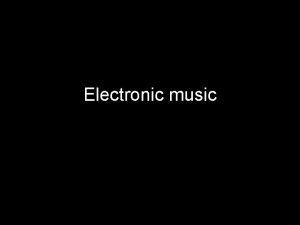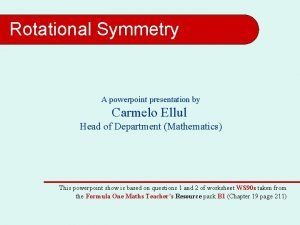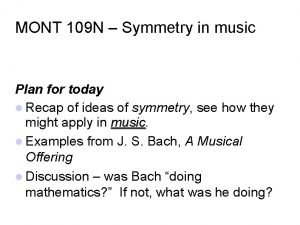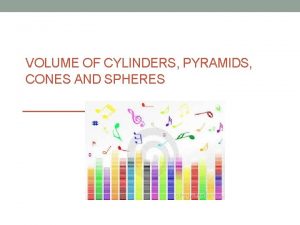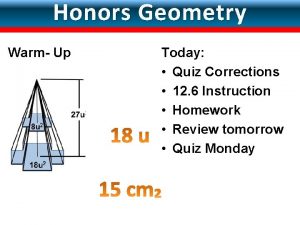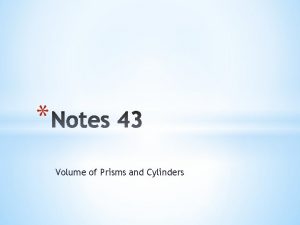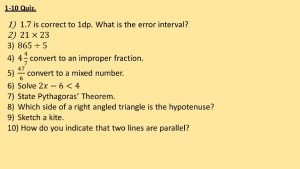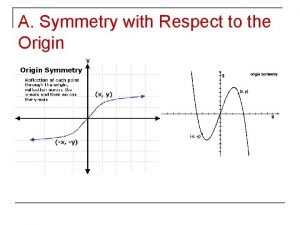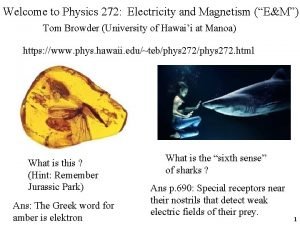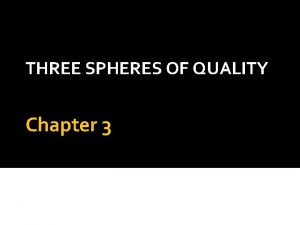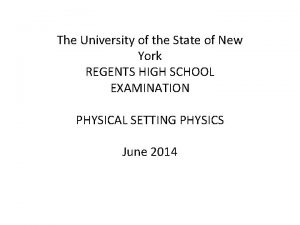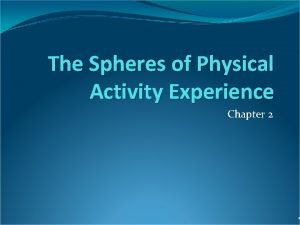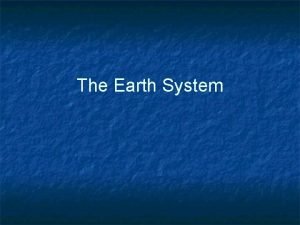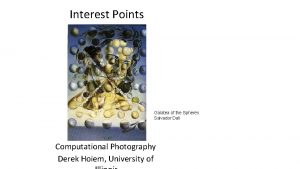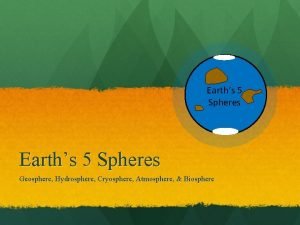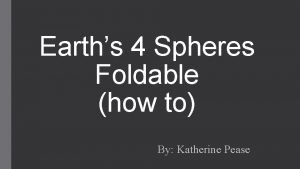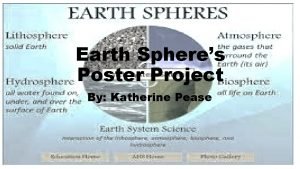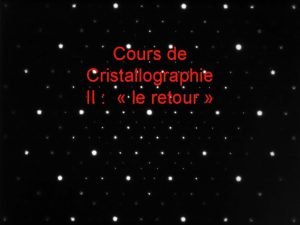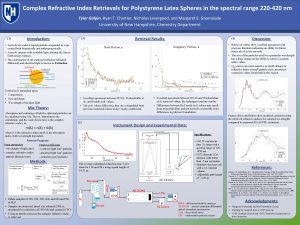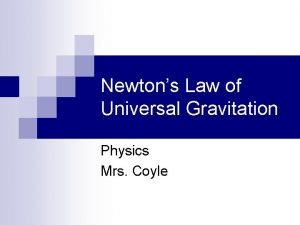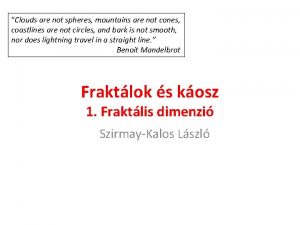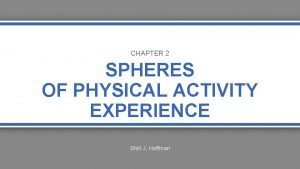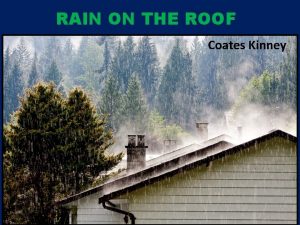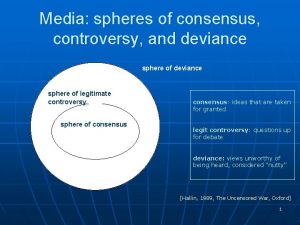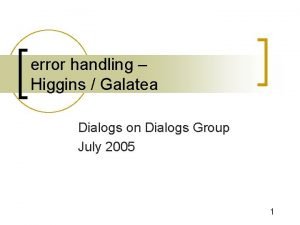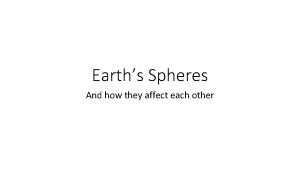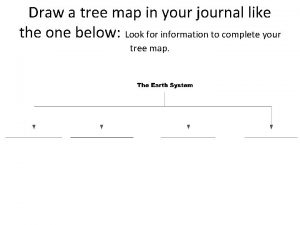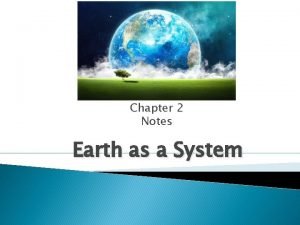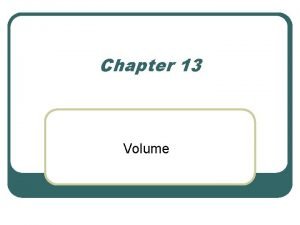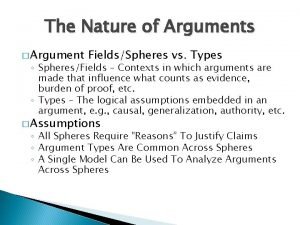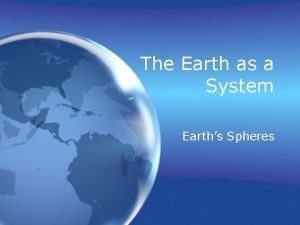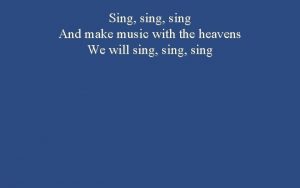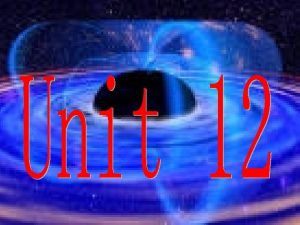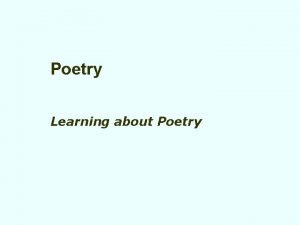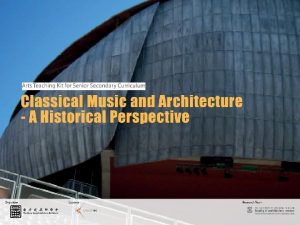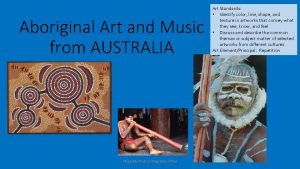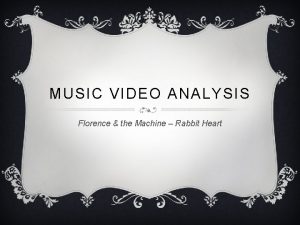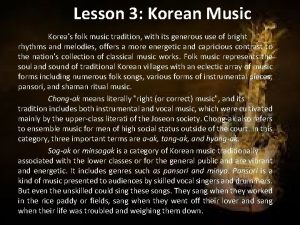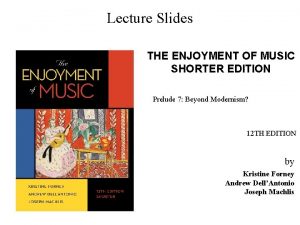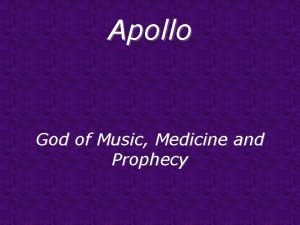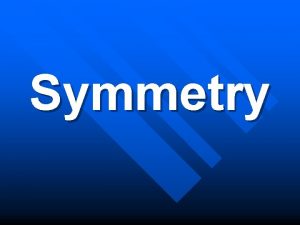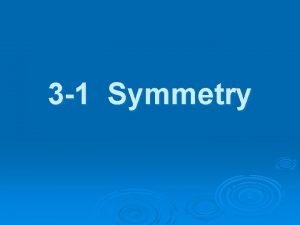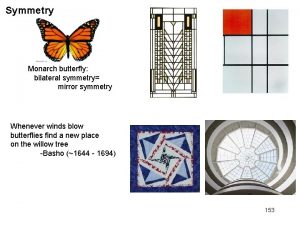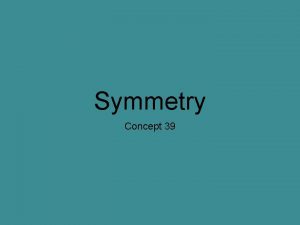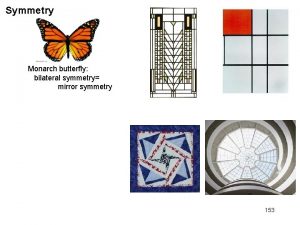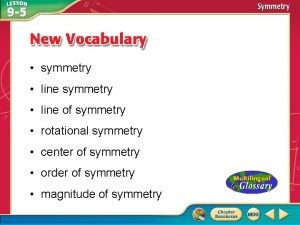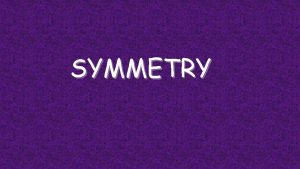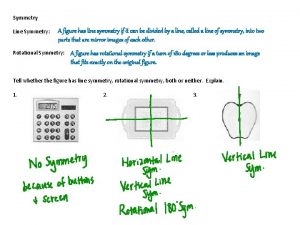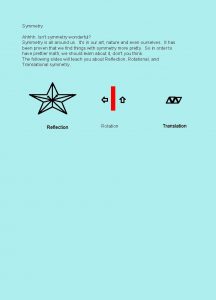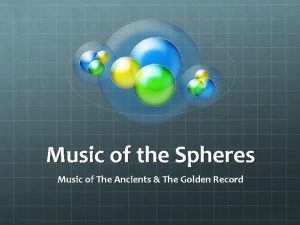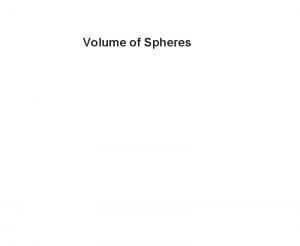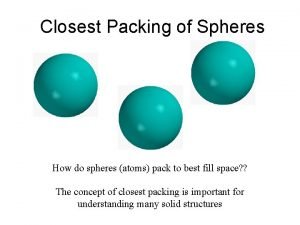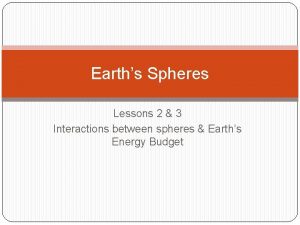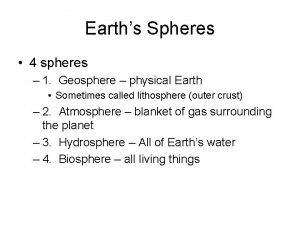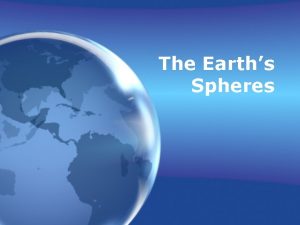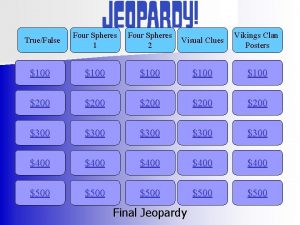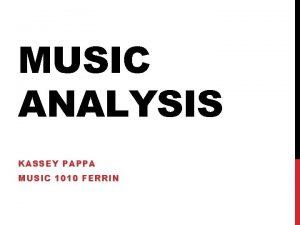The Music of the Spheres symmetry and symmetry


















![Kepler: planetary orbits are ellipses; not perfect circles Johannes Kepler [1571 - 1630] Kepler’s Kepler: planetary orbits are ellipses; not perfect circles Johannes Kepler [1571 - 1630] Kepler’s](https://slidetodoc.com/presentation_image_h2/2254f819079c9b3b55a7f972498e3239/image-19.jpg)



























































































- Slides: 110

The Music of the Spheres -- symmetry and symmetry breaking in Nature -- Stephen Lars Olsen Seoul National University

Symmetry & Beauty

Hokusai 1760 -1849 24 views of Fuji View 18 View 20

Hiroshige 1797 -1858 36 views of Fuji View 4 View 14

Temple of heaven (Beijing)

From a different angle

Seoul Arts Center 만화경

Snowflakes 600

Kaleidoscope 만화경

How it works Start with a random pattern Include a reflection Use mirrors to repeat it over & over te 0 a t ro 45 by The attraction is all in the symmetry

Rotational symmetry qq 2 1 No matter which way I turn a perfect sphere It looks identical

Space translation symmetry corn field in the US midwest

Ocean surface far from land Differences from place to place: • Direction that a compass needle points • Locations of the stars • Time of sunrise & sunset

Crystal Lattice

Silicon

Timetranslation symmetry in music t a e ep r t re a pe in a ag & n i a g a & n i aga

Time translation (near) symmetry 1995 1994 1993 1992 1991 College entrance exam College entrance exam Weather in Seoul

Prior to Kepler, Galileo, etc God is perfect, therefore nature must be perfectly symmetric: Planetary orbits must be perfect circles Celestial objects must be perfect spheres
![Kepler planetary orbits are ellipses not perfect circles Johannes Kepler 1571 1630 Keplers Kepler: planetary orbits are ellipses; not perfect circles Johannes Kepler [1571 - 1630] Kepler’s](https://slidetodoc.com/presentation_image_h2/2254f819079c9b3b55a7f972498e3239/image-19.jpg)
Kepler: planetary orbits are ellipses; not perfect circles Johannes Kepler [1571 - 1630] Kepler’s 1 st law: published in July 1609 (500 years ago)


Galileo & his telescope 1 st recorded observations were in July 1609 (500 years ago) Discoveries: • Moons of Jupiter • Saturn’s rings • Phases of Venus • Mountains on the Moon

Moons of Jupiter Discovered by Galileo on January 7, 1610 Galileo’s sketches of the Moons’ changing locations modern photos

Rings of saturn Sketch of Saturn by Galileo in 1616

Phases of Venus Galileo's sketch of the phases on Venus Clear evidence that Venus orbits the Sun (& not the Earth) Modern photos of Venus

& mountains on the Moon

Modern photo of the Moon obviously not a perfect sphere

Symmetries of the laws of Nature

Newton’s laws implicitly assume that they are valid for all times in the past, present & future Processes that we see occurring in these distant Galaxies actually happened billions of years ago Newton’s laws have time-translation symmetry

The Bible agrees that nature is time-translation symmetric Ecclesiastes 1. 9 The thing that hath been, it is that which shall be; and that which is done is that which shall be done: and there is no new thing under the sun 전도서 1. 9 이미 있던 것이 후에 다시 있겠고 이미 한 일을 후에 다시 할지라 해 아래에는 새 것이 없나니

Newton believed that his laws apply equally well everywhere in the Universe Newton realized that the same laws that cause apples to fall from trees here on Earth, apply to planets billions of miles away from Earth. Newton’s laws have space-translation symmetry

rotational symmetry F=ma F Same rule for all directions a (no “preferred” directions in space. ) a F Newton’s laws have rotation symmetry

Symmetry recovered Symmetry resides in the laws of nature, not necessarily in the solutions to these laws.

Conservation Laws

Conservation of Momentum= mass x velocity total momentum before = total momentum after

Conservation of Momentum on a billiard table ntum e m o m Total m 1 V 1 f Momentum Vectors before and after m. V 2 2 f m 1 V 1 i Total momentum before = Total momentum after Slide from Jang Jae-won

Empirical verification (1) Experiment in billiard room Actual speed video clip Direction Analysis Slide from Jang Jae-won

eating Finding nemo

Concept of Kinetic Energy K. E. = ½ MV 2 Emilie du Châtelet (1706 -1749) Brilliant mathematician One of Voltaire’s lovers

Conservation of energy on a Billiard Table total Kinetic Energy before = total Kinetic Energy after V 1 f Only for 90 o triangles! 90 o V 2 f V 1 i Pythagoras 90 o

Empirical verification Experiment in billiard room Actual speed video clip Direction Analysis Slide from Jang Jae-won

Empirical verification Experiment in billiard room Actual speed video clip Direction Analysis SNU students are excellent billiard players!! Slide from Jang Jae-won

Conservation of angular momentum Z Slide from Lee Jaekeum -Z gravity

Emmy Noether Conserved Symmetry: Conservation quantities: something laws are stayconsequences the same that stays the throughout a ofsame symmetries process a throughout process 1882 - 1935

Symmetries Conservation laws Conservation law Symmetry Angular momentum Space translation Momentum Time translation Energy Rotation

Symmetry in modern physics

Two great scientific discoveries of the 20 th Century: • Relativity 2 E=mc • Quantum theory

Quantum theory & Atomic spectra

Decoding atomic spectra Mercury spectrum photon Ephoton=E 2 -E 1 quantum energies “quantum jump” quantum orbits Mercury energy levels

1924 Otto Laporte Laport rule even odd Otto Laporte 1902 -1971 even odd Allowed quantum states are either even or odd even X even odd X odd OK not allowed

Laporte rule is a consequence of Left-Right symmetry of Nature Eugene Wigner 1902 -1995 Left Right symmetry = “Parity” symmetry 1963 Nobel Physics prize “for the discovery and application of fundamental symmetry principles”

P = Parity = L R/R L Field (& rules) of football are parity symmetric Rules of baseball are not parity symmetric

Which one is better looking?

Ryu, Hyun Jin Slide from Lee Jaekeum

Even & Odd quantum functions Even Function L R R L Does not change Parity = +1 Odd Function L R R L Changes sign Parity = -1

Parity Conservation in QM Left Right symmetry of Nature Conservation of Parity even state photon has P=-1 odd state initially: finally: even state (Peven=+1) odd state + Photon (Pphot=-1) (Podd=-1) Pinitial=+1 Pfinal=(-1)=+1 Parity is conserved

Paul Adrien Maurice Dirac 1902 - 1984 1933 Nobel Physics prize “for the discovery of new Productive forms of atomic theory” Combined relativity & Quantum Mechanics

y py = m. Vy electron e- p = m. V x px = m. Vx 2 2 2 mc E =( ) E = ± mc 2 px can be + or E also can be + or -

QM waves: wavelength: l=h/p frequency: f=E/h positive l electron going forward in space negative l electron going backward in space positive f electron going forward in time ? ? negative f electron going backwards in time

What does it mean to move backwards in time?

backward time motion - B - - t - when viewed forward in time: L : C R : P -

When viewed forward in time: a negatively charged electron going backwards in time appears as an equal mass positively charged particle Carl Anderson ant iele ctro no Positron discovered by Anderson in 1933 1905 -1991 1936 Nobel Physics Prize r “p osi tron ”

hydrogen electron p+ Anti-hydrogen - antielectron antiproton + p- identical forces Anti-hydrogen atoms are made routinely at the CERN laboratory in Switzerland. It is found to have the same size and allowed energy levels as ordinary hydrogen

Anti-Carbon + + + Quantum theory equations for carbon & anticarbon are identical • antielectrons • antineutrons • antiprotons Although it would be impossibly difficult to make anti-atoms more complex than antihydrogen, it is in principle possible

Charge –conjugation (C) symmetry Nature is particle antiparticle symmetric

Violation of Parity Conservation

q-t puzzle 1949 1947 cloud chamber q+ photographic emulsion p+ q+ t + p +p +p - p +p 0 mt = 970 me (495 Me. V) mq ≈ mp/2 R. Brown et al. , Nature 163, 47, 82 (1949) G. D. Rochester & C. C. Butler, Nature 160, 855 (1947) p has odd parity: P(p) = -p P(q ) =+ q q has even parity same mass, same lifetime, opposite P P(t ) = -t t has odd parity

Lee and Yang Phys Rev 104, 254 (1956) T. D. Lee C. N. Yang The q+ and t+ are the same particle, and its decays violate Parity. (now known as the K+ meson)

Parity violation discovered in radioactivity _ Co 60 Ni 60 e- n more electrons are emitted opposite to the nuclear spin direction than along it J J WU, Chien Shiung 1912 -97 C. S. Wu et al. , Phys. Rev. 105 (1957), 1415. The mirror image, where electrons are emitted parallel to the spin, doesn’t occur in Nature.

1957 Nobel Prize Yang, Chen-Ning Lee, Tsung-Dao "for their penetrating investigation of the so-called parity laws which has led to important discoveries regarding the elementary particles" WU, Chien Shiung

Violation of Charge-Conjugation Symmetry

P-violations in m- & m+ decay also r adioa _ decays: e- emission opposite to spin direction preferred m- e -n n m le tic Par o ymm i v is le s ar p i t n roces ses + m d e t la etry C e + e ctive p tic A R L Garwin, L M Lederman and M Weinrich Phys. Rev. 105, 1415 (1957 ) _ decays: e+ emission parallel to spin direction preferred m+ e +n n

C x P in m decay at e d Mirrored antimatter case does occur in Nature ol d Vi o Vi e lat CP m P C e sy r t e m m s i y e+ K O + m “charg conjug e ate” mirror

But…

Dilemma Laws of physics are very symmetric between matter & antimatter Nature is very asymmetric between matter & antimatter no antimatter here

Big-Bang Cosmology Then: a“no-hair” Universe matter = antimatter Now: people Only mass, electric charge & angular momentum no antipeople

Where are the antipeople? Need to have violations of “CP” symmetry

Search for CP asymmetries in nature

Use neutral K mesons “strange” particles d s rk ua q e g ran st anti- s d ark qu strange Why are neutral kaons interesting? They “mix: ” s d d s ~0. 5 nanosecs d s s d

Physics of weakly coupled systems http: //www. citesciences. fr/francais/web_cite/experime/citelab/PENDULE/ENGLISH/exper. htm http: //www. walter-fendt. de/ph 14 i/cpendula_i. htm

Stationary modes observed neutral kaons: CP: +1 (-1)=+1 X CP: -1 (-1)(-1) = -1 X not allowed if nature is CP symmetric

Christenson-Cronin-Fitch-Turlay Experiment (1964) Search for KCPodd p+p- p+ CP-odd Kaons p-

KCPodd p+p- Small CP violation (2 x 10 -3) is seen J. H. Christenson et al. , PRL 13 (1964), 138.

1980 Nobel Prize No prizes for Christenson or Turlay

Incorporating matter-antimatter differences into Quantum Theory For example, differences between the strengths for: K 0 p+p- & _ K 0 p+p- --- Not Easy ----

In Quantum Theory processes are described by complex numbers K 0 p+p- real imaginary A imaginary ● _ _ A ● real For CP violation, the two numbers must be different

_ ● A _ x q. CP ● K 0 p+p- _ K 0 p+p- imaginary A theorem (CPT theorem) says the lengths of A A and A A must be equal A real _ A and A can only differ by an angle (“CP phase”) But in Quantum Theorem the strength of a process only depends on _ the lengths, thus in this case, K 0 p+p- and K 0 p+p- are the same, even if there is a CP violating angle.

There must be another way… _ x q. CP K 0 p+p- _ A ● imaginary K 0 p+p- A ● ● real C ● +p. C is another (common) way for a neutral K p _ that is the same for K 0 & K 0

Strengths = vector sums of A & C _ ● A A C C q. CP - +p 0 p K ● real _ K 0 p +p - _ Now the decay strengths for K 0 & K 0 are different and we have matter-antimatter differences

How to incorporate a CPV angle into theory for quarks?

2008 Nobel Physics Prize Kobayashi & Maskawa explained CP violation within the framework of the Standard Model, but required that the Model be extended to three doublets of quarks. These predicted, hypothetical new quarks have recently appeared in physics experiments. As late as 2001, the two particle detectors Ba. Bar at Stanford, USA and Belle at Tsukuba, Japan, both detected CP violations independently of each other. The results were exactly as Kobayashi and Maskawa had predicted almost three decades earlier. Makoto Kobayashi Toshide Maskawa

Three Quarks for Müster Mark 1963: all known nuclear particles are made from three basic building-blocks: fractionally charged quarks (and their three anti-quark partners). Murray Gell-Mann q= 2/3 proton q=-1/3 p+-meson

Quarks In 1973, there were still only 3 known quarks (u, d, s): But K & M were convinced of the existence of a 4 th quark: the hypothesized “charmed” quark (c): q= 2/3 c q=-1/3 K & M called this the “the quartet scheme”

K. M. Paper, page 1: their reasons were essentially purely mathematical

K. M. Paper, page 7: we can get CP violation, but only with 6 quarks

Why were K&M so sure of the c quark? In 1972, they both were in Nagoya, where Kiyoshi Niu was on the Expt’l Particle Physics Faculty 2 mm Shuzo Ogawa (Nagoya) interpreted this event as production of one paritcle with a c-quark (X p 0 p) and one with an anti-c-quark (X p 0 p±).

History November 1974: Charmed (4 th) quark “discovered” @ Brookhaven & SLAC J/ = c c 1976 Nobel prize M(e+e-) pp J/ + X; J/ e+e. Phys. Rev. Lett. 33: 1404 -1406, 1974. Ecm(e+e-) e+e- hadrons Phys. Rev. Lett. 33: 1406 -1408, 1974 Sam Ting Burt Richter Kiyoshi Niu

More History November 1977: Bottom (5 th) quark discovered @ Fermilab = bb February 1995: Top (6 th) quark discovered @ Fermilab ℓ+ n _ _ pp t t X _ bc Phys. Rev. Lett. 39: 252 -255, 1977. CDF: Phys. Rev. Lett. 74: 2626 -2631, 1995 D 0: Phys. Rev. Lett. 74: 2632 -2637, 1995

Use B mesons to test KM i. e. mesons containing the b- (5 th) quark B 0 = d b 0 0 B /B B 0 = b d similar to 0 0 K /K

Why B mesons? _ 1) B 0 mixing is strong 2 ps B 0 N(B) + N(B) B 0 ---------------- _ _ N(B) – N(B) B 0 ei mt _ B 0 _ If you start with a B 0, it changes to a B 0 (& vice versa) with about 2 ps 2) b quarks are sensitive to CPV phases - they in the “third”-plet

KEK laboratory in Japan Tsukuba Mountain KEKB Collider KEK laboratory

elle A magnetic spectrometer based on a huge superconducting solenoid

Sanda, Bigi , Carter technique for f 1 J/ B 0 KCPeven sin 2 q. CP J/ B 0 KCPeven

What do we measure? B 0 & _0 B in an quan “entang tum state led” e “Flavor-tag” _ decay (B 0 or B 0 ? ) J/ e KCPeven z B-B B+B (tags) sin 2 q. CP more B tags t=0 t t This is for KCPeven; for KCPodd, the asymmetry is opposite

Belle 2007 Experimental Results PRL 98: 003802 (2007) B 0 tag ~7500 evts _ B 0 tag ~6500 evts B 0 tag CP=+1 _ B 0 tag CP=-1 q. CP = 21. 50 ± 1. 00 Similar results from the Ba. Bar experiment at SLAC Ba. Bar, Phys. Rev. Lett. 87: 091801, 2001 Belle, Phys. Rev. Lett. 87: 091802, 2001

Compare with KM theory constraints from other processes Ba. Bar & Belle measurement q. CP | _ Vtd Vcb Nobel committee: “The results were exactly as Kobayashi and Maskawa had predicted…”

Stockholm, December 2008

Conclusions • Laws of Nature have a number of symmetries -these symmetries all have related conservation laws • Theory has a high degree of matter-antimatter symmetry -Nature does not • K M incorporated matter-antimatter asymmetry into theory -but required 6 quark types (when only 3 types were known) • 4 th, 5 th, and 6 th quarks (c-, b-, & t-quarks) were discovered • KM mechanism verified in b-quark decays

Does the KM mechanism explain Nature’s matter-antimatter asymmetry? No! Not by 10 orders-of-magnitude! But -- thanks to KM -- we now know: How CP violations fit into theory New physics processes must occur How to search for this New Physics --we are now upgrading Belle to do this

1927: Nature is Left-Right symmetric Parity is an important symmetry Laporte Summary Wigner 1956: Radioactivity processes violate Parity, but CP symmetry is preserved Yang Lee 1964: CP is violated too Cronin Fitch 1973: CP violations require 6 quark flavors Kobayashi 20? ? : New source of CP violation is found? Maskawa ?

 Music music music
Music music music Classical vs romantic art
Classical vs romantic art Loudness or quietness of music
Loudness or quietness of music Employs electronic musical instruments
Employs electronic musical instruments Ilocano folk song pamulinawen
Ilocano folk song pamulinawen Rotational symmetry diagram
Rotational symmetry diagram Symmetry in music
Symmetry in music Finding the volume of cylinders pyramids cones and spheres
Finding the volume of cylinders pyramids cones and spheres 12-6 surface areas and volumes of spheres
12-6 surface areas and volumes of spheres Volume of prisms and cylinders
Volume of prisms and cylinders Area of sectors maze geometry
Area of sectors maze geometry How to find volume of cone
How to find volume of cone Quiz 1 circles and spheres
Quiz 1 circles and spheres Y axis symmetry origin symmetry neither
Y axis symmetry origin symmetry neither You have two lightweight metal spheres each hanging
You have two lightweight metal spheres each hanging Three spheres of recognition
Three spheres of recognition The components of a 15 meters per second
The components of a 15 meters per second Networking spheres
Networking spheres Physical activity professionals contribute to work
Physical activity professionals contribute to work Compare terrarium to earth system
Compare terrarium to earth system Four spheres of the earth
Four spheres of the earth Spheres of knowledge
Spheres of knowledge Lesson 9.3 volume of spheres answer key
Lesson 9.3 volume of spheres answer key Keypoint matching
Keypoint matching Cryosphere hydrosphere biosphere geosphere and atmosphere
Cryosphere hydrosphere biosphere geosphere and atmosphere Earth's spheres foldable
Earth's spheres foldable Earth's spheres poster project
Earth's spheres poster project Identify which sphere of earth each image represents.
Identify which sphere of earth each image represents. Maille primitive cfc
Maille primitive cfc Polystyrene index of refraction
Polystyrene index of refraction Living soil vs dead soil
Living soil vs dead soil Two spheres of mass 35kg are 60m apart
Two spheres of mass 35kg are 60m apart Clouds are not spheres
Clouds are not spheres Seven spheres of physical activity
Seven spheres of physical activity Starry spheres figure of speech
Starry spheres figure of speech Sphere of consensus
Sphere of consensus Galatea of the spheres meaning
Galatea of the spheres meaning Earth's spheres
Earth's spheres Spheres of the earth concept map
Spheres of the earth concept map Earth systems foldable
Earth systems foldable Earths 4 spheres
Earths 4 spheres Geosphere and atmosphere
Geosphere and atmosphere Volume of cylinder lesson 13-1 answer key
Volume of cylinder lesson 13-1 answer key Argument spheres
Argument spheres Spheres of the earth
Spheres of the earth Hình ảnh bộ gõ cơ thể búng tay
Hình ảnh bộ gõ cơ thể búng tay Lp html
Lp html Bổ thể
Bổ thể Tỉ lệ cơ thể trẻ em
Tỉ lệ cơ thể trẻ em Chó sói
Chó sói Chụp phim tư thế worms-breton
Chụp phim tư thế worms-breton Hát lên người ơi
Hát lên người ơi Môn thể thao bắt đầu bằng từ chạy
Môn thể thao bắt đầu bằng từ chạy Thế nào là hệ số cao nhất
Thế nào là hệ số cao nhất Các châu lục và đại dương trên thế giới
Các châu lục và đại dương trên thế giới Công thức tiính động năng
Công thức tiính động năng Trời xanh đây là của chúng ta thể thơ
Trời xanh đây là của chúng ta thể thơ Mật thư anh em như thể tay chân
Mật thư anh em như thể tay chân Làm thế nào để 102-1=99
Làm thế nào để 102-1=99 Phản ứng thế ankan
Phản ứng thế ankan Các châu lục và đại dương trên thế giới
Các châu lục và đại dương trên thế giới Thơ thất ngôn tứ tuyệt đường luật
Thơ thất ngôn tứ tuyệt đường luật Quá trình desamine hóa có thể tạo ra
Quá trình desamine hóa có thể tạo ra Một số thể thơ truyền thống
Một số thể thơ truyền thống Cái miệng nó xinh thế
Cái miệng nó xinh thế Vẽ hình chiếu vuông góc của vật thể sau
Vẽ hình chiếu vuông góc của vật thể sau Biện pháp chống mỏi cơ
Biện pháp chống mỏi cơ đặc điểm cơ thể của người tối cổ
đặc điểm cơ thể của người tối cổ V cc cc
V cc cc Vẽ hình chiếu đứng bằng cạnh của vật thể
Vẽ hình chiếu đứng bằng cạnh của vật thể Tia chieu sa te
Tia chieu sa te Thẻ vin
Thẻ vin đại từ thay thế
đại từ thay thế điện thế nghỉ
điện thế nghỉ Tư thế ngồi viết
Tư thế ngồi viết Diễn thế sinh thái là
Diễn thế sinh thái là Các loại đột biến cấu trúc nhiễm sắc thể
Các loại đột biến cấu trúc nhiễm sắc thể Thế nào là số nguyên tố
Thế nào là số nguyên tố Tư thế ngồi viết
Tư thế ngồi viết Lời thề hippocrates
Lời thề hippocrates Thiếu nhi thế giới liên hoan
Thiếu nhi thế giới liên hoan ưu thế lai là gì
ưu thế lai là gì Hổ sinh sản vào mùa nào
Hổ sinh sản vào mùa nào Khi nào hổ con có thể sống độc lập
Khi nào hổ con có thể sống độc lập Hệ hô hấp
Hệ hô hấp Từ ngữ thể hiện lòng nhân hậu
Từ ngữ thể hiện lòng nhân hậu Thế nào là mạng điện lắp đặt kiểu nổi
Thế nào là mạng điện lắp đặt kiểu nổi Featured during sabbath and other holy days.
Featured during sabbath and other holy days. Sing sing sing and make music with the heavens
Sing sing sing and make music with the heavens Art and music are my favorite subject
Art and music are my favorite subject Poem about music and life
Poem about music and life Dapayanin
Dapayanin 1950's music trivia questions and answers
1950's music trivia questions and answers Cello notes for beginners
Cello notes for beginners Sing and make music in your heart to the lord
Sing and make music in your heart to the lord Chapter 10. western musical instruments
Chapter 10. western musical instruments Bhootha aradhane
Bhootha aradhane Classical music architecture
Classical music architecture Australian aboriginal art and music
Australian aboriginal art and music Country of oneat
Country of oneat Sing sing sing and make music with the heavens
Sing sing sing and make music with the heavens A conical drum of maranao.
A conical drum of maranao. Unit 4 music and arts
Unit 4 music and arts Florence and the machine lyrics
Florence and the machine lyrics Folk songs religious works court music and shaman rituals
Folk songs religious works court music and shaman rituals Chapter 67 neo romantic evocations
Chapter 67 neo romantic evocations Jesus is king and i will extol him
Jesus is king and i will extol him First music video on mtv
First music video on mtv Rhythm composition
Rhythm composition God of poetry music medicine and light
God of poetry music medicine and light Race records and hillbilly music
Race records and hillbilly music



